ZFS - Building, Testing, and Benchmarking
by Matt Breitbach on October 5, 2010 4:33 PM EST- Posted in
- IT Computing
- Linux
- NAS
- Nexenta
- ZFS
Benchmarks
After running our tests on the ZFS system (both under Nexenta and OpenSolaris) and the Promise M610i, we came up with the following results. All graphs have IOPS on the Y-Axis, and Disk Que Lenght on the X-Axis.
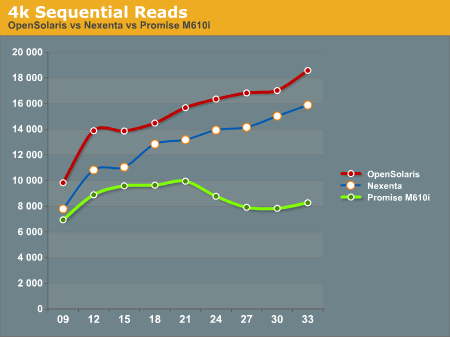
In the 4k Sequential Read test, we see that the OpenSolaris and Nexenta systems both outperform the Promise M610i by a significant margin when the disk queue is increased. This is a direct effect of the L2ARC cache. Interestingly enough the OpenSolaris and Nexenta systems seem to trend identically, but the Nexenta system is measurably slower than the OpenSolaris system. We are unsure as to why this is, as they are running on the same hardware and the build of Nexenta we ran was based on the same build of OpenSolaris that we tested. We contacted Nexenta about this performance gap, but they did not have any explanation. One hypothesis that we had is that the Nexenta software is using more memory for things like the web GUI, and maybe there is less ARC available to the Nexenta solution than to a regular OpenSolaris solution.
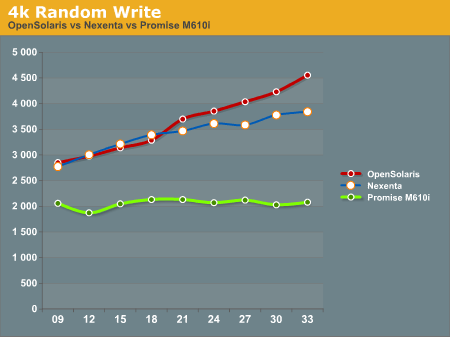
In the 4k Random Write test, again the OpenSolaris and Nexenta systems come out ahead of the Promise M610i. The Promise box seems to be nearly flat, an indicator that it is reaching the limits of its hardware quite quickly. The OpenSolaris and Nexenta systems write faster as the disk queue increases. This seems to indicate a better re-ordering of data to make the writes more sequential the disks.

The 4k 67% Write 33% Read test again gives the edge to the OpenSolaris and Nexenta systems, while the Promise M610i is nearly flat lined. This is most likely a result of both re-ordering writes and the very effective L2ARC caching.
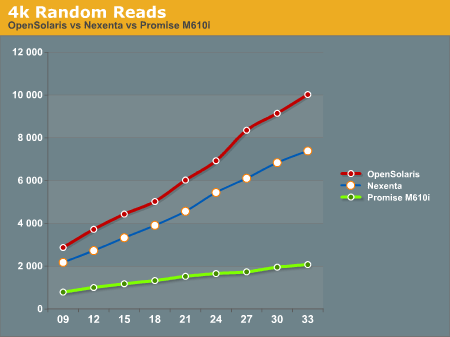
4k Random Reads again come out in favor of the OpenSolaris and Nexenta systems. While the Promise M610i does increase its performance as the disk queue increases, it's nowhere near the levels of performance that the OpenSolaris and Nexenta systems can deliver with their L2ARC caching.
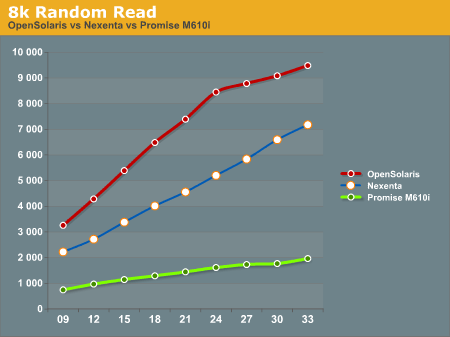
8k Random Reads indicate a similar trend to the 4k Random Reads with the OpenSolaris and Nexenta systems outperforming the Promise M610i. Again, we see the OpenSolaris and Nexenta systems trending very similarly but with the OpenSolaris system significantly outperforming the Nexenta system.
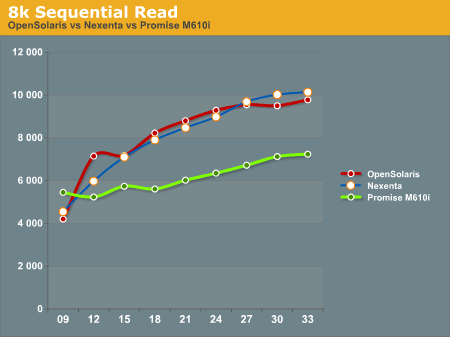
8k Sequential reads have the OpenSolaris and Nexenta systems trailing at the first data point, and then running away from the Promise M610i at higher disk queues. It's interesting to note that the Nexenta system outperforms the OpenSolaris system at several of the data points in this test.
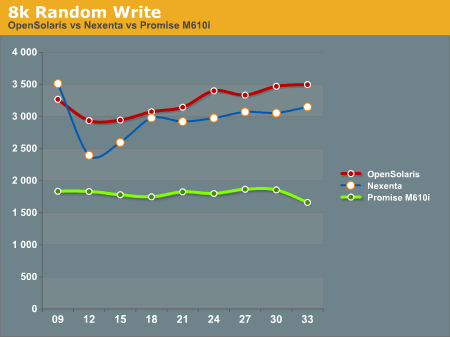
8k Random writes play out like most of the other tests we've seen with the OpenSolaris and Nexenta systems taking top honors, with the Promise M610i trailing. Again, OpenSolaris beats out Nexenta on the same hardware.
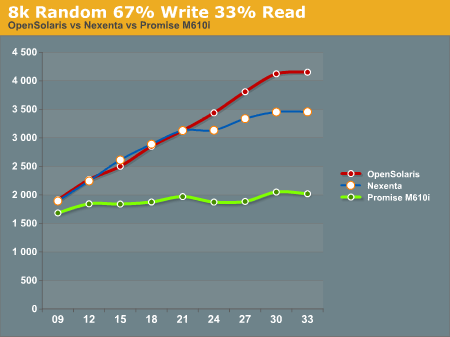
8k Random 67% Write 33% Read again favors the OpenSolaris and Nexenta systems, with the Promise M610i trailing. While the OpenSolaris and Nexenta systems start off nearly identical for the first 5 data points, at a disk queue of 24 or higher the OpenSolaris system steals the show.
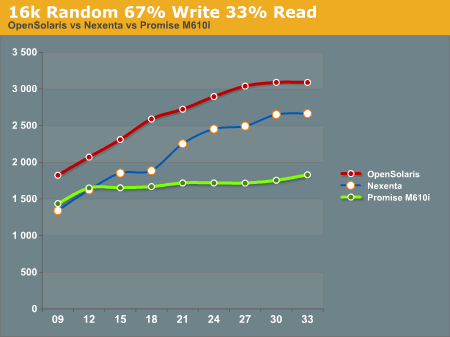
16k Random 67% Write 33% read gives us a show that we're familiar with. OpenSolaris and Nexenta both soundly beat the Promise M610i at higher disk ques. Again we see the pattern of the OpenSolaris and Nexenta systems trending nearly identically, but the OpenSolaris system outperforming the Nexenta system at all data points.
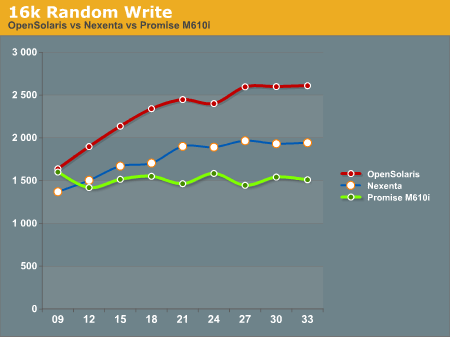
16k Random write shows the Promise M610i starting off faster than the Nexenta system and nearly on par with the OpenSolaris system, but quickly flattening out. The Nexenta box again trends higher, but cannot keep up with the OpenSolaris system.
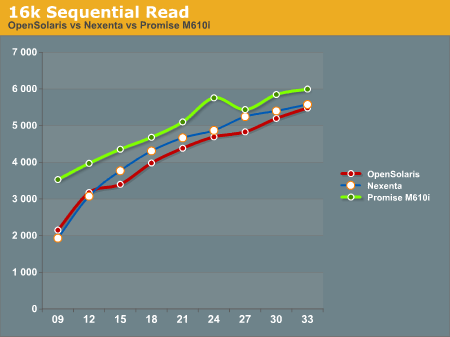
The 16k Sequential read test is the first test that we see where the Promise M610i system outperforms OpenSolaris and Nexenta at all data points. The OpenSolaris system and the Nexenta system both trend upwards at the same rate, but cannot catch the M610i system.
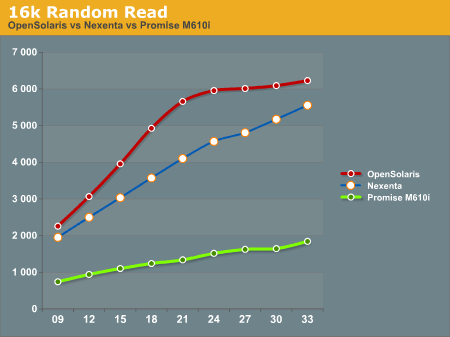
The 16k Random Read test goes back to the same pattern that we've been seeing, with the OpenSolaris and Nexenta systems running away from the Promise M610i. Again we see the OpenSolaris system take top honors with the Nexenta system trending similarly, but never reaching the performance metrics seen on the OpenSolaris system.

32k Random 67% Write 33% read has the OpenSolaris system on top, with the Promise M610i in second place, and the Nexenta system trailing everything. We're not really sure what to make of this, as we expected the Nexenta system to follow similar patterns to what we had seen before.
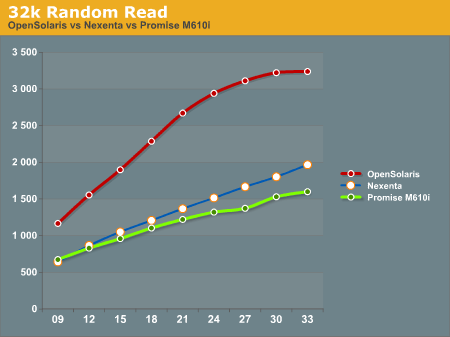
32k Random Read has the OpenSolaris system running away from everything else. On this test the Nexenta system and the Promise M610i are very similar, with the Nexentaq system edging out the Promise M610i at the highest queue depths.
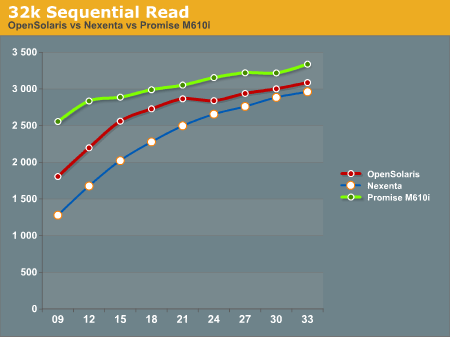
32k Sequential Reads proved to be a strong point for the Promise M610i. It outperformed the OpenSolaris and Nexenta systems at all data points. Clearly there is something in the Promise M610i that helps it excel at 32k Sequential Reads.

32k random writes have the OpenSolaris system on top again, with the Promise M610i in second place, and the Nexenta system trailing far behind. All of the graphs trend similarly, with little dips and rises, but not ever moving much from the initial reading.
After all the tests were done, we had to sit down and take a hard look at the results and try to formulate some ideas about how to interpret this data. We will discuss this in our conclusion.










102 Comments
View All Comments
vla - Tuesday, October 5, 2010 - link
Along the lines of the "Opensolaris is kind of dead" threads, I'd really like to see an article like this for BTRFS. It's about to become the standard filesystems for Fedora and Ubuntu in the near future, and I'd love to get some AnandTech depth articles about it.. what it can do, what it can't. How it compares to existing Linux filesystems, how it compares to ZFS, etc.andersenep - Tuesday, October 5, 2010 - link
When btrfs is ready for production use, let me know. From what I have seen it is still very much experimental. When it's as stable and proven as ZFS, I would love to give it a try. I have severe doubts that Oracle will continue to invest in its development now that it owns ZFS.Khyron320 - Wednesday, October 6, 2010 - link
I have never heard of any caching feature mentioned for BTRFS and it is not mentioned on the wiki anywhere. Is this a planned feature?http://en.wikipedia.org/wiki/Btrfs#Features
Sabbathian - Wednesday, October 6, 2010 - link
Only site where you can find articles like these.... thank you guys ... ;)lecaf - Wednesday, October 6, 2010 - link
Hiwhy not do some extra testing with Windows Storage Server R2 (just released a few days ago)
I'm sure it would lag behind but it could be interesting to see how much.
Mattbreitbach - Wednesday, October 6, 2010 - link
I do not believe that Windows Storage Server is an end-user product. I believe that it is only released to OEM's to ship on their systems. At this time we have no route to obtain Windows Storage Server.lecaf - Wednesday, October 6, 2010 - link
True its OEM only and not public but "evaluation" version is available with Technet and MSDNWithout a license key you can run it for 180 days (like all new MS OS BTW)
but you can also try this
http://www.microsoft.com/specializedservers/en/us/...
Just a registration and you get the software. (Read license because benchmarking is sometimes prohibited)
Sivar - Wednesday, October 6, 2010 - link
BSD supports ZFS as well, and it is far from dead.Of course, it's also far from popular.
Guspaz - Wednesday, October 6, 2010 - link
"We decided to spend some time really getting to know OpenSolaris and ZFS."OpenSolaris is a dead operating system, killed off by Oracle. Points for testing Nexenta, since they're the ones driving the fork that seems to be the successor to OpenSolaris, but basing your article around a dead-end OS isn't very helpful to your readers...
Mattbreitbach - Wednesday, October 6, 2010 - link
When this project was started, OpenSolaris was far from dead. We decided to keep using OpenSolaris to finish the article because a viable alternative wasn't available until three weeks ago. If we were to start this article today, it would be based on OpenIndiana. Some of our preliminary testing of OpenIndiana indicate that it performs even better than OpenSolaris in most tests.